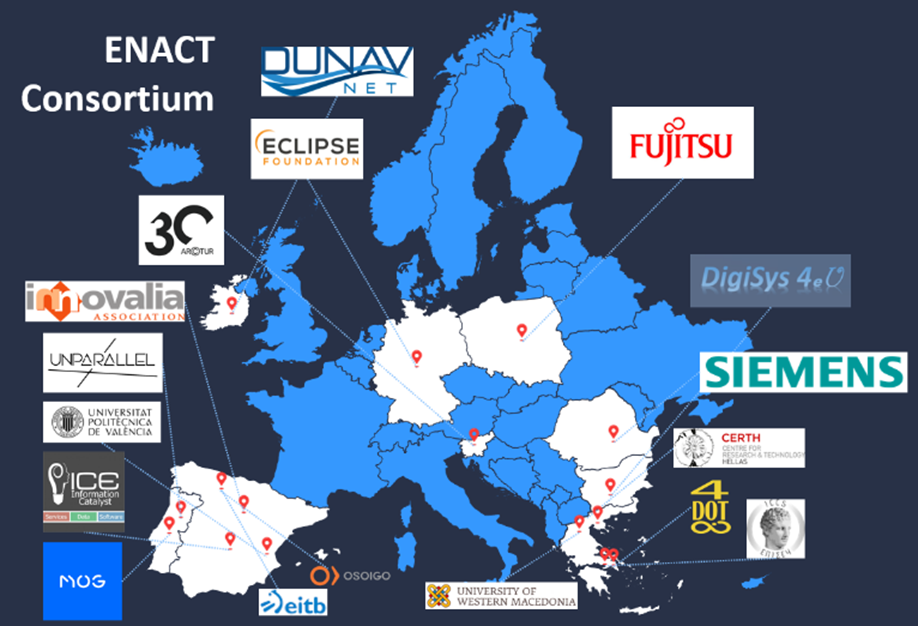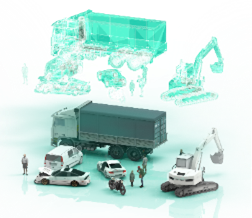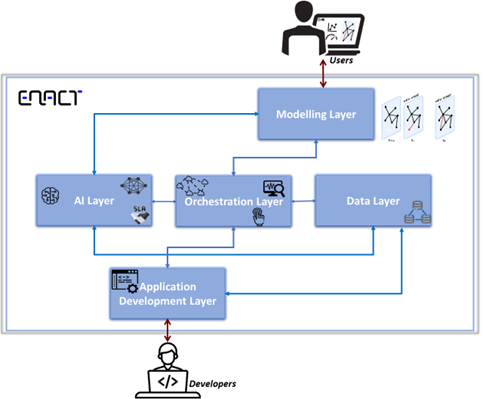ENACT, which stands for Adaptive Scheduling and Deployments of Data Intensive Workloads on Energy Efficient Edge to Cloud Continuum, aims to design and deliver a powerful, flexible Cognitive Computing Continuum (CCC) that enables seamless and efficient deployment of data-intensive applications across heterogeneous infrastructures—ranging from edge devices to cloud environments. In today’s dynamic digital landscape, where real-time responsiveness and scalability are essential, ENACT provides a comprehensive technological framework that empowers developers and edge-cloud service providers to build adaptive, secure, and AI-compliant solutions.
At the heart of ENACT lies the ambition to support both infrastructure-level adaptability and application-level applicability. Infrastructure-level adaptability allows systems to exploit the full range of computational resources available across the continuum, dynamically adjusting to changes in workload, availability, or energy constraints. Application-level adaptability, on the other hand, equips applications with self-optimizing capabilities, enabling them to autonomously fine-tune their performance based on contextual information and resource conditions.
To turn this vision into reality, ENACT delivers a suite of cutting-edge technologies and AI-powered mechanisms. These include tools for automatic discovery and onboarding of resources, intelligent modelling and scheduling algorithms, and orchestration services that manage distributed deployments with minimal human intervention. Moreover, ENACT emphasizes data interoperability, security by design, and compliance with European regulations such as the AI Act.
The project is driven by a strong and diverse consortium of 17 partners from 9 European countries, combining leading expertise in edge and cloud computing, artificial intelligence, application automation, and open-source development, aiming to push the boundaries of innovation.

ENACT aims to achieve a well-defined and meaningful set of objectives:
- To optimize the execution of distributed applications by dynamically balancing workloads and resource allocation across the continuum.
- To enable intelligent, proactive deployment of applications that can adapt to changes in context, resource availability, and system conditions.
- To support the decentralized coordination of hyper-distributed applications, encouraging openness, transparency, and autonomy in business interactions.
- To provide developers with a comprehensive toolbox for building intelligent applications capable of learning from—and reacting to—conditions in other parts of the system.
- To prepare the foundations for large-scale adoption of ENACT technologies by organizations of all sizes and from various sectors.
- To validate the platform in real-world pilots that demonstrate its ability to manage distributed resources and process data efficiently in complex environments.
- To foster knowledge-sharing and community-building to strengthen Europe’s leadership in software innovation.
To validate ENACT technologies and innovations, three diverse and demanding use cases (UC) will be implemented as a part of the project:
|
UC1: Media and Entertainment – In partnership with MOG Technologies, we are enhancing the live annotation and streaming of sports content, reducing latency and increasing the energy efficiency of broadcasts.
|
 |
| UC2: Immersive Experiences – In collaboration with EITB and Osoigo, we are transforming the broadcasting of the Regata de la Concha rowing competition using VR and XR technologies, creating a more engaging and interactive experience for spectators. |  |
| UC3: Mobility Digital Twins – Led by Fujitsu, this use case applies ENACT’s capabilities to smart mobility scenarios, using digital twins to monitor emissions and optimize air quality in urban environments. |  |
To realize its vision of a dynamic and intelligent computing continuum, ENACT relies on a robust and modular architecture. This architecture is critical for enabling seamless coordination across edge and cloud resources, ensuring that applications can adapt in real time to changing conditions and demands. It lays the foundation for the project’s technological innovations—spanning orchestration, modelling, AI-driven optimization, and secure data handling. The high-level architecture of ENACT, illustrated in the figure below, is composed of five interoperating layers, each playing a distinct role in supporting hyper-distributed, self-adaptive applications.

These layers are:
- Orchestration Layer: Automatically configures and monitors edge-cloud resources using Zero-Touch Provisioning and a cognitive orchestrator.
- Modelling Layer: Models resource topology and performs security risk analysis using advanced dynamic graph techniques.
- AI Layer: Employs AI models—such as Graph Neural Networks and Deep Reinforcement Learning—to optimize application deployment.
- Data Layer: Implements a secure data space for distributed telemetry and AI data, ensuring data sovereignty and transparency.
- Application Development Layer: Supports developers with tools for adaptive application deployment, including a Software Development Kit (SDK) and compliance mechanisms for the AI Act.
This layered architecture not only ensures flexibility and scalability, but also enables a high degree of automation and intelligence across the entire edge-cloud continuum. With this solid technical foundation in place, ENACT is now progressing steadily toward the realization of its ambitious goals.
Main achievements
As we reflect on the first year of the project, we are proud to highlight several key achievements that mark important milestones in our journey. We began with a thorough state-of-the-art analysis across all relevant ENACT technological domains, ensuring that our developments build upon and advance the existing research and commercial landscape. Based on this groundwork, the team successfully designed the ENACT CCC reference architecture, detailing the specifications and requirements for each core component. Alongside architectural work, we defined our three real-world use cases, carefully selecting them to demonstrate the platform’s adaptability, performance, and impact in different sectors—from media to mobility. To ensure meaningful evaluation, we established clear KPIs, identified relevant data sources, and outlined both pilot architectures and demonstration scenarios for testing our innovations in realistic environments. Technical development has advanced rapidly, with initial implementations of most components already completed and integration activities actively underway to ensure interoperability across the system. Looking ahead, we are preparing for the first release of the ENACT CCC platform in June 2025, a major milestone that will mark the beginning of broader community engagement and testing. In parallel, ENACT has also made progress in its commitment to openness, with source code contributions already published and maintained as an official Eclipse Foundation open-source project. Finally, the project has achieved strong visibility through active participation in more than ten dissemination events and the publication of several scientific papers, consolidating its position within the European research ecosystem.
These accomplishments mark only the beginning. As we continue to develop and validate our platform, we remain committed to fostering collaboration and advancing open innovation.
